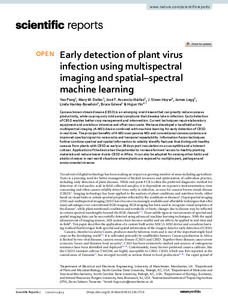| dc.contributor.author | Peng, Y. |
| dc.contributor.author | Dallas, M.M. |
| dc.contributor.author | Ascencio‑Ibanez, J.T. |
| dc.contributor.author | Hoyer, J.S. |
| dc.contributor.author | Legg, J. |
| dc.contributor.author | Hanley‑Bowdoin, L. |
| dc.contributor.author | Grieve, B. |
| dc.contributor.author | Yin, H. |
| dc.date.accessioned | 2023-03-01T07:57:15Z |
| dc.date.available | 2023-03-01T07:57:15Z |
| dc.date.issued | 2022-02-24 |
| dc.identifier.citation | Peng, Y., Dallas, M.M., Ascencio-Ibáñez, J.T., Hoyer, J.S., Legg, J., Hanley-Bowdoin, L., ... & Yin, H. (2022). Early detection of plant virus infection using multispectral imaging and spatial–spectral machine learning. Scientific Reports, 12(1): 3113, 1-14. |
| dc.identifier.issn | 2045-2322 |
| dc.identifier.uri | https://hdl.handle.net/20.500.12478/8069 |
| dc.description.abstract | Cassava brown streak disease (CBSD) is an emerging viral disease that can greatly reduce cassava productivity, while causing only mild aerial symptoms that develop late in infection. Early detection of CBSD enables better crop management and intervention. Current techniques require laboratory equipment and are labour intensive and often inaccurate. We have developed a handheld active multispectral imaging (A-MSI) device combined with machine learning for early detection of CBSD in real-time. The principal benefits of A-MSI over passive MSI and conventional camera systems are improved spectral signal-to-noise ratio and temporal repeatability. Information fusion techniques further combine spectral and spatial information to reliably identify features that distinguish healthy cassava from plants with CBSD as early as 28 days post inoculation on a susceptible and a tolerant cultivar. Application of the device has the potential to increase farmers’ access to healthy planting materials and reduce losses due to CBSD in Africa. It can also be adapted for sensing other biotic and abiotic stresses in real-world situations where plants are exposed to multiple pest, pathogen and environmental stresses. |
| dc.format.extent | 1-14 |
| dc.language.iso | en |
| dc.subject | Plant Viruses |
| dc.subject | Machine Learning |
| dc.subject | Cassava |
| dc.subject | Productivity |
| dc.title | Early detection of plant virus infection using multispectral imaging and spatial-spectral machine learning |
| dc.type | Journal Article |
| cg.contributor.crp | Roots, Tubers and Bananas |
| cg.contributor.affiliation | University of Manchester |
| cg.contributor.affiliation | North Carolina State University |
| cg.contributor.affiliation | Rutgers University |
| cg.contributor.affiliation | International Institute of Tropical Agriculture |
| cg.coverage.region | Africa |
| cg.coverage.region | East Africa |
| cg.coverage.country | Kenya |
| cg.coverage.country | Uganda |
| cg.coverage.hub | Eastern Africa Hub |
| cg.researchtheme | Plant Production and Health |
| cg.identifier.bibtexciteid | PENG:2022 |
| cg.isijournal | ISI Journal |
| cg.authorship.types | CGIAR and advanced research institute |
| cg.iitasubject | Agronomy |
| cg.iitasubject | Cassava |
| cg.iitasubject | Food Security |
| cg.iitasubject | Plant Breeding |
| cg.iitasubject | Plant Diseases |
| cg.iitasubject | Plant Health |
| cg.iitasubject | Plant Production |
| cg.journal | Scientific Reports |
| cg.notes | Open Access Journal; Published online: 24 Feb 2022 |
| cg.accessibilitystatus | Open Access |
| cg.reviewstatus | Peer Review |
| cg.usagerightslicense | Creative Commons Attribution 4.0 (CC BY 0.0) |
| cg.targetaudience | Scientists |
| cg.identifier.doi | https://dx.doi.org/10.1038/s41598-022-06372-8 |
| cg.iitaauthor.identifier | James Legg: 0000-0003-4140-3757 |
| cg.futureupdate.required | No |
| cg.identifier.issue | 1 |
| cg.identifier.volume | 12 |

